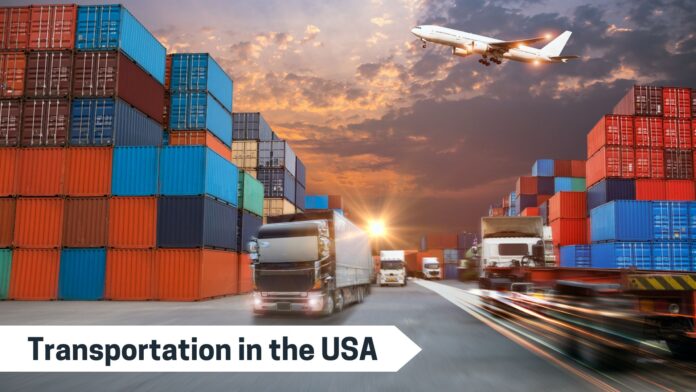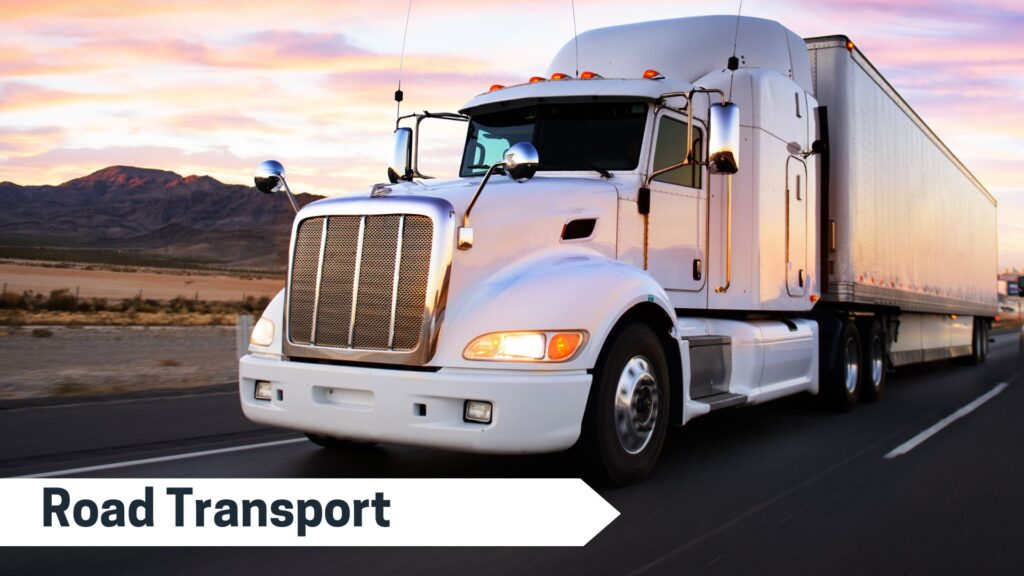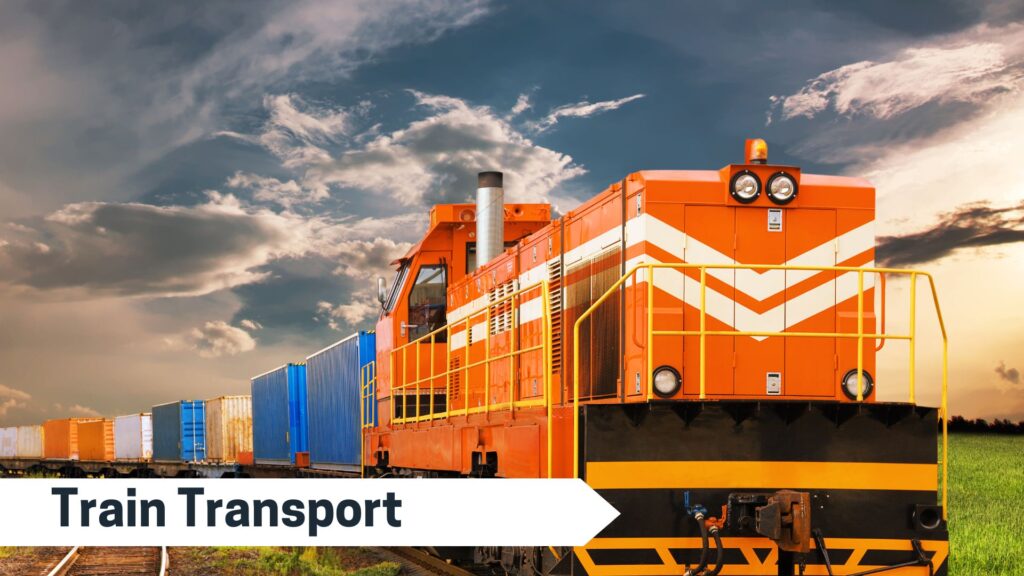
Table of Contents – Transportation in the USA
1. Introduction to Transportation in the USA
From bustling metropolises to picturesque countryside, the United States offers a diverse landscape that demands efficient and reliable transportation systems. Navigating the vast expanse of the country requires a variety of transportation options, each catering to different needs and preferences. In this guide, we’ll delve into the various modes of transportation available in the USA and explore their features, advantages, and considerations.
2. Road Transportation

Driving Culture and Infrastructure
The USA is renowned for its extensive road network, encompassing highways, interstates, and scenic byways that crisscross the nation. With a strong driving culture deeply ingrained in American society, personal vehicles remain the primary mode of transportation for many residents. The country’s well-maintained roads and infrastructure make road travel a convenient and accessible option for commuting, leisure travel, and long-distance road trips.
Public Transportation -Transportation in the USA
In urban areas, public transportation systems provide an alternative to driving, offering commuters and travelers a convenient way to navigate cities and suburbs. Major cities like New York, Chicago, and San Francisco boast extensive public transit networks, including subways, buses, light rail, and commuter trains, facilitating efficient and affordable transportation for millions of passengers daily.
3. Air Transportation

Commercial Airlines -Transportation in the USA
Air travel plays a vital role in connecting distant destinations across the vast expanse of the USA. The country is served by a robust network of commercial airlines, operating domestic and international flights to and from major airports nationwide. From transcontinental flights between coastlines to regional flights serving smaller cities and towns, air transportation offers speed, efficiency, and convenience for travelers covering long distances.
General Aviation -Transportation in the USA
In addition to commercial airlines, general aviation plays a significant role in providing air transportation services to communities across the USA. General aviation encompasses private and corporate aircraft, charter flights, flight training, and recreational flying activities. General aviation airports and airstrips serve as gateways to remote areas, offering access to regions where commercial airlines may be less accessible.
4. Rail Transportation

Rail Networks -Transportation in the USA
Rail transportation has a storied history in the USA, dating back to the development of transcontinental railroads in the 19th century. Today, passenger rail services provide an alternative mode of travel for commuters and leisure travelers alike. Amtrak, the national passenger rail service, operates long-distance and regional train routes connecting major cities and regions across the country, offering a scenic and relaxing way to travel.
Urban Transit Systems -Transportation in the USA
In urban areas, commuter rail and light rail systems complement traditional rail services, providing efficient transportation options for residents and visitors. Cities like New York, Boston, and Washington, D.C., feature extensive commuter rail networks that serve suburban areas and outlying regions, while light rail systems offer intra-city transportation within urban cores, promoting mobility and reducing congestion.
5. Water Transportation
Maritime Trade and Transportation -Transportation in the USA
Water transportation plays a vital role in facilitating maritime trade and commerce in the USA. Major seaports along the Atlantic, Pacific, Gulf, and Great Lakes coasts serve as gateways for international shipping, handling vast volumes of cargo and goods. Inland waterways, such as the Mississippi River system, support domestic shipping and transportation of commodities like grain, petroleum, and raw materials.
Ferry Services -Transportation in the USA
In coastal regions and island communities, ferry services provide essential transportation links, connecting mainland destinations with islands and peninsulas. Ferry routes operate across bodies of water such as the Puget Sound, San Francisco Bay, and Long Island Sound, offering passengers a scenic and convenient way to travel between coastal destinations.
6. Emerging Trends and Innovations -Transportation in the USA
Shared Mobility -Transportation in the USA
The rise of shared mobility services, including ridesharing, bike-sharing, and scooter-sharing, has transformed urban transportation dynamics in recent years. Companies like Uber, Lyft, and Lime offer convenient and accessible options for short-distance trips, reducing reliance on personal vehicles and easing congestion in urban centers.
Electric and Autonomous Vehicles -Transportation in the USA
Advancements in electric vehicle (EV) technology and autonomous vehicle (AV) technology are shaping the future of transportation in the USA. EV adoption is on the rise, driven by environmental concerns and government incentives, while AV development promises to revolutionize the way people and goods are transported, offering potential benefits in safety, efficiency, and mobility.
8. Challenges and Solutions in Transportation -Transportation in the USA
While the transportation infrastructure in the USA is robust, it also faces several challenges that impact efficiency, sustainability, and accessibility.
Traffic Congestion: Transportation in the USA, Urban areas often experience significant traffic congestion, resulting in delays, increased fuel consumption, and environmental pollution. Addressing traffic congestion requires a multifaceted approach, including investments in public transit, transportation demand management strategies, and the promotion of alternative modes of transportation such as cycling and walking.
Infrastructure Maintenance: The maintenance and repair of aging transportation infrastructure, including roads, bridges, and public transit systems, present ongoing challenges. Adequate funding and long-term planning are essential to ensure the safety, reliability, and resilience of transportation networks across the country.
Equity and Accessibility: Access to transportation services is not equitable for all communities, particularly those in rural and underserved areas. Addressing transportation equity requires a focus on improving access to transportation options, reducing transportation barriers for disadvantaged populations, and ensuring that transportation investments benefit all members of society.
Sustainability and Environmental Impact: Transportation accounts for a significant portion of greenhouse gas emissions and air pollution in the USA. Promoting sustainable transportation solutions, such as electric vehicles, public transit, and active transportation modes, can help reduce emissions, mitigate climate change, and improve air quality.
Technological Integration: Integrating emerging technologies such as connected vehicles, smart infrastructure, and mobility-as-a-service platforms presents both opportunities and challenges for transportation systems. Maximizing the benefits of technology while addressing concerns related to data privacy, cybersecurity, and digital equity is essential for building a transportation system that meets the needs of all users. Transportation in the USA
9. Future Trends and Outlook -Transportation in the USA
Looking ahead, several trends are expected to shape the future of transportation in the USA:
Electrification: The adoption of electric vehicles is expected to continue growing, driven by advancements in battery technology, declining costs, and government incentives. Electric vehicles have the potential to reduce greenhouse gas emissions, improve air quality, and enhance energy security.
Autonomous Vehicles: Autonomous vehicles have the potential to revolutionize transportation by increasing safety, reducing congestion, and enhancing mobility for seniors and individuals with disabilities. However, challenges related to regulation, safety standards, and public acceptance must be addressed before widespread deployment.
Shared Mobility: Shared mobility services such as ridesharing, bike-sharing, and scooter-sharing are expected to continue expanding, offering convenient and flexible transportation options for urban residents. Integrating shared mobility services with public transit can enhance connectivity and promote multimodal transportation solutions.
Infrastructure Investments: Investments in transportation infrastructure are essential for maintaining and modernizing roads, bridges, public transit systems, and other critical assets. Funding mechanisms such as public-private partnerships, congestion pricing, and user fees may be explored to support infrastructure investments.
Climate Resilience: Building climate-resilient transportation infrastructure is crucial for mitigating the impacts of extreme weather events, sea-level rise, and other climate-related challenges. Strategies such as green infrastructure, flood protection measures, and adaptive design can help enhance the resilience of transportation networks.
11. Public-Private Partnerships -Transportation in the USA
Public-private partnerships (PPPs) play a significant role in advancing transportation infrastructure projects in the USA. PPPs involve collaboration between government agencies and private sector entities to finance, develop, and operate transportation projects. These partnerships leverage the strengths of both sectors, combining public funding and oversight with private sector expertise and efficiency. PPPs have been used successfully for a wide range of transportation projects, including toll roads, bridges, airports, and public transit systems & Transportation in the USA.
One notable example of a successful PPP in the USA is the Denver Eagle P3 project, which involved the construction of three new commuter rail lines, an extension of an existing light rail line, and a new transit maintenance facility in the Denver metropolitan area. The project was delivered through a PPP arrangement between the Regional Transportation District (RTD) and a private consortium, which provided financing, design, construction, and operation services. The project was completed on schedule and within budget, demonstrating the effectiveness of PPPs in delivering complex transportation projects.
12. Environmental Sustainability – Transportation in the USA
Promoting environmental sustainability is a key priority for transportation planning and policy in the USA. Sustainable transportation practices aim to reduce greenhouse gas emissions, improve air quality, and minimize the environmental impact of transportation activities. Several strategies are being pursued to advance environmental sustainability in transportation, including:
- Electrification of vehicles: Transitioning to electric vehicles (EVs) reduces emissions from transportation and helps mitigate climate change. Federal and state governments offer incentives and subsidies to encourage the adoption of EVs, and investments are being made in charging infrastructure to support widespread EV use.
- Alternative fuels: Beyond electrification, efforts are underway to promote alternative fuels such as hydrogen, natural gas, and biofuels for transportation. These fuels offer lower emissions and reduced dependence on fossil fuels, contributing to environmental sustainability and energy security.
- Active transportation: Encouraging walking, cycling, and other forms of active transportation reduces reliance on motor vehicles and promotes physical activity and public health. Investments in pedestrian and cycling infrastructure, such as bike lanes and sidewalks, help create safer and more accessible environments for active transportation.
- Transit-oriented development: Transit-oriented development (TOD) promotes compact, mixed-use development around transit hubs, reducing the need for car travel and encouraging walking, cycling, and the use of public transit. TOD strategies integrate land use and transportation planning to create vibrant, sustainable communities.
13. Equity and Inclusion -Transportation in the USA
Ensuring equity and inclusion in transportation planning and decision-making is essential for creating transportation systems that serve all members of society equitably. Historically, transportation planning has disproportionately impacted marginalized communities, leading to disparities in access to transportation services, economic opportunities, and quality of life. Addressing these inequities requires a comprehensive approach that considers the needs and priorities of diverse communities.
- Access to transportation: Providing equitable access to transportation services is critical for connecting people to jobs, education, healthcare, and essential services. Improving public transit service levels, expanding transit networks to underserved areas, and implementing fare equity policies can help reduce transportation barriers for low-income and disadvantaged communities.
- Community engagement: Engaging communities in the transportation planning process ensures that their voices are heard and their concerns are addressed. Meaningful community engagement practices, such as public meetings, workshops, and outreach events, facilitate dialogue and collaboration between transportation agencies and community stakeholders.
- Transportation justice: Transportation justice seeks to address the historical and systemic inequities in transportation planning and policy. This includes addressing issues such as environmental justice, racial equity, and accessibility for people with disabilities, ensuring that transportation investments benefit all members of society fairly and equitably.
By prioritizing equity, inclusion, and social justice in transportation planning and decision-making, the USA can create transportation systems that promote economic opportunity, social mobility, and quality of life for all residents, regardless of race, income, or ability.
15. Technological Advancements – Transportation in the USA
The transportation sector in the USA is witnessing rapid technological advancements that are revolutionizing how people and goods move. These innovations are driving efficiency, safety, and sustainability across all modes of transportation. Here are some key technological advancements shaping the future of transportation:
- Connected Vehicles: Connected vehicle technology enables vehicles to communicate with each other and with transportation infrastructure, such as traffic signals and roadside sensors. This connectivity improves traffic flow, enhances safety through collision avoidance systems, and enables real-time data exchange to optimize transportation operations.
- Smart Infrastructure: Smart infrastructure solutions leverage sensors, cameras, and data analytics to monitor traffic conditions, manage congestion, and enhance safety on roads and highways. Intelligent transportation systems (ITS) use technology to improve traffic management, incident response, and traveler information dissemination.
- Mobility-as-a-Service (MaaS): Mobility-as-a-Service platforms integrate various transportation options, such as public transit, ridesharing, bikesharing, and scooter-sharing, into a seamless, user-centric experience. MaaS apps provide travelers with real-time information, trip planning, and multimodal payment options, promoting efficient and sustainable mobility solutions.
- Autonomous Vehicles (AVs): Autonomous vehicle technology has the potential to transform transportation by enabling self-driving vehicles to navigate roads safely and efficiently. AVs offer opportunities for improved mobility, increased safety, and enhanced accessibility for individuals who are unable to drive, such as seniors and people with disabilities.
- Drone Delivery: Unmanned aerial vehicles (drones) are being used for delivery of goods and services, particularly in remote or hard-to-reach areas. Drone delivery services offer fast, efficient, and cost-effective solutions for transporting medical supplies, emergency response equipment, and consumer goods.
- Hyperloop and High-Speed Rail: Hyperloop technology and high-speed rail systems promise to revolutionize long-distance travel by offering ultra-fast transportation options between major cities. Hyperloop pods and high-speed trains can travel at speeds of hundreds of miles per hour, reducing travel times and congestion on traditional transportation routes.
16. Resilience and Adaptation -Transportation in the USA
As the impacts of climate change become increasingly evident, resilience and adaptation are critical considerations for transportation planning and infrastructure development in the USA. Extreme weather events, rising sea levels, and changing precipitation patterns pose significant challenges to transportation systems, requiring proactive measures to enhance resilience and mitigate risks.
- Climate Resilient Design: Designing transportation infrastructure with climate resilience in mind involves incorporating measures to withstand and adapt to the impacts of climate change. This may include elevating roadways and bridges to mitigate flooding, reinforcing coastal infrastructure to withstand storm surges, and using resilient materials that can withstand temperature extremes and weather-related deterioration.
- Green Infrastructure: Green infrastructure practices, such as permeable pavements, green roofs, and rain gardens, can help manage stormwater runoff and reduce the risk of flooding and erosion. Incorporating green infrastructure into transportation projects can enhance sustainability, improve water quality, and mitigate the urban heat island effect.
- Adaptive Management: Adaptive management approaches involve continuously monitoring and adjusting transportation strategies and infrastructure in response to changing environmental conditions. This flexible and iterative process allows transportation agencies to anticipate and address emerging challenges, ensuring that transportation systems remain resilient and responsive to evolving climate risks.
- Emergency Preparedness: Effective emergency preparedness and response planning are essential for mitigating the impacts of natural disasters and other emergencies on transportation systems. Developing robust emergency management plans, coordinating inter-agency response efforts, and investing in disaster recovery capabilities can help minimize disruptions and expedite recovery efforts in the event of a crisis.
By prioritizing resilience, adaptation, and sustainability in transportation planning and infrastructure development, the USA can build a transportation system that is better equipped to withstand the impacts of climate change, protect public safety, and ensure continued mobility and connectivity for all residents.
17. International Collaboration -Transportation in the USA
In an increasingly interconnected world, international collaboration plays a vital role in addressing global transportation challenges, sharing best practices, and promoting innovation and cooperation. The USA actively engages with international partners, organizations, and initiatives to advance transportation goals and objectives on a global scale.
- International Standards and Guidelines: Participating in international forums and organizations allows the USA to contribute to the development of international standards and guidelines for transportation planning, design, and operation. Aligning with global best practices helps ensure interoperability, consistency, and compatibility of transportation systems across borders.
- Knowledge Sharing and Capacity Building: Sharing knowledge, expertise, and resources with international partners fosters mutual learning and capacity building in transportation planning and management. Collaborative initiatives, such as training programs, workshops, and technical exchanges, promote innovation and excellence in transportation practices worldwide.
- Multilateral Partnerships and Agreements: Engaging in multilateral partnerships and agreements enables the USA to address transboundary transportation issues, such as cross-border trade, infrastructure development, and environmental protection. Collaborative efforts, such as regional transportation corridors and cross-border infrastructure projects, facilitate economic integration and connectivity between countries.
- Research and Innovation Collaboration: Collaborating on research and innovation initiatives with international partners enhances the USA’s access to cutting-edge technologies, expertise, and resources. Joint research projects, technology demonstrations, and innovation hubs facilitate cross-border collaboration and accelerate the development and deployment of innovative transportation solutions.
By fostering international collaboration and cooperation, the USA can leverage global expertise and resources to address common transportation challenges, promote sustainable development, and enhance connectivity and mobility for people and goods around the world.
18. Conclusion -Transportation in the USA
Transportation is a cornerstone of economic prosperity, social connectivity, and environmental sustainability in the USA and beyond. By embracing innovation, resilience, and collaboration, the USA can build a transportation system that meets the needs of a rapidly changing world, enhances mobility and accessibility, and fosters prosperity and well-being for all.
Through strategic investments, forward-thinking policies, and collaborative partnerships, the USA can address the challenges and opportunities facing transportation in the 21st century. By working together to create a transportation system that is efficient, resilient, and equitable, the USA can build a brighter future for generations to come.




















